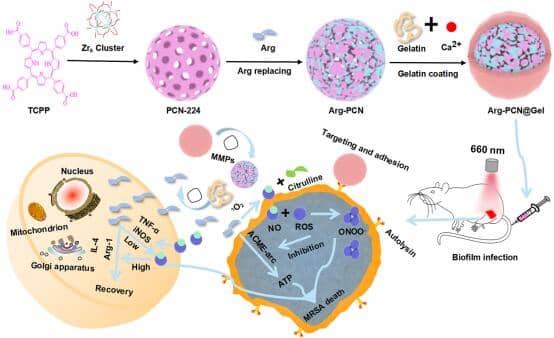Recently, our college scholars cleverly designed a precision nanosystems with a synergistic effect of cascaded photodynamic therapy and nutritional immunotherapy, which effectively resists biofilm infections via a new antibacterial mechanism. The relevant achievements were published in Science advances under the title of "Targeting and Arginine driven Synergizing Photodynamic Therapy with Nutritional Immunoherapy Nanosystems for Combining MRSA Biofilms". This study design a targeting and synergizing cascade-PDT with nutritional immunotherapy nanosystems (Arg-PCN@Gel) containing core PCN-224 as PDT platform for providing ROS, incorporating arginine (Arg) as NO donor to cascade with ROS to produce more lethal ONOO- and promote immune response, and coating with gelatin as targeting agent and persistent Arg provider. The composite nanosystems showed targeting and synergistic photodynamic and nutritional immunotherapy against methicillin-resistant Staphylococcus aureus (MRSA) biofilm
MRSA, an important zoonotic pathogen, can use biofilms to evade the killing effects of host immune systems and antibiotics, leading to persistent infections, posing a serious threat to human health and causing huge economic losses to animal husbandry. Conventional antibiotics often have low efficacy due to their non-specific distribution and the biofilm barrier, and are highly susceptible to inducing bacterial resistance. Therefore, there is an urgent need to develop new treatment strategies that have efficient anti biofilm effects and are not easy to induce drug resistance..
Photodynamic therapy achieves non-specific killing of bacteria through the production of reactive oxygen species and is not easy to induce bacterial resistance. Therefore, this study cleverly designed a photodynamic triggering cascade reaction core-shell composite nanosystems (Arg-PCN@Gel). The core PCN-224 as prepared by photosensitizers (PS) of meso-tetrakis (4-carboxyphenyl) porphyrin (TCPP) and metal zirconium (Zr) to enhance the biofilms penetration and light capture capacity. Arg was doped into PCN-224 to form Arg-PCN to achieve the cascading and synergizing effects of 1O2 and NO as well as to enhance the immune response of host. Finally, Arg-PCN was covered with hydrophilic gelatin to provide targeting delivery performance as well as persistent Arg donor. The Arg-PCN@Gel can target MRSA mediated by atl and then release the core Arg-PCN via over-expressing of MMPs at the infection sites. Under irradiation, the nanosystems can produce different active substances of ROS, NO and ONOO- in cascade reaction and stimulate Arg-enhanced immunity to synergistically prevent and treat biofilms. The nanosystems suppressed MRSA Arg and element metabolism, energy usage efficiency, two-component systems, EPS synthesis to prevent biofilms formation by down-regulating cidA, icaA, arsR, copZ, codY, ccpA, and others. It used NO to effectively break mature biofilms barrier to help ROS and ONOO- penetrate into biofilms to damage internal MRSA cell wall and membrane. Simultaneously, the firstly produced low level of NO by Arg-PCN@Gel under the irradiation induced the pro-inflammatory factor of TNF-α and iNOS expression, and further utilized Arg to produce a large amount of NO for achieving antibacterial effects. Subsequently, the gradually accumulated NO not only cleared bacteria, but also induced the anti-inflammatory factor of IL-4 and Arg-1 expression, thereby utilizing Arg to promote wound healing by the transformation of infected tissue from the pro-inflammatory stage to the anti-inflammatory stage. The Arg-PCN@Gel will be a novel promising effective way to fight against biofilm-associated infections. .

Aoxue Zhang, a doctoral student, is the first author. Professor Dongmei Chen and Professor Shuyu Xie are the co-corresponding authors. Some of other students in the research group participated in the work. This study is supported by the National Natural Science Foundation of China, National key research and development
Link:https://www.science.org/doi/10.1126/sciadv.adg9116